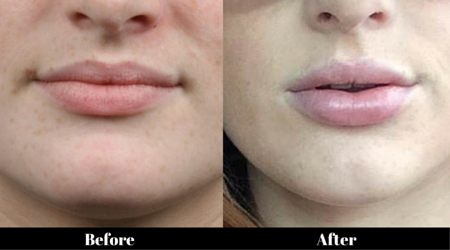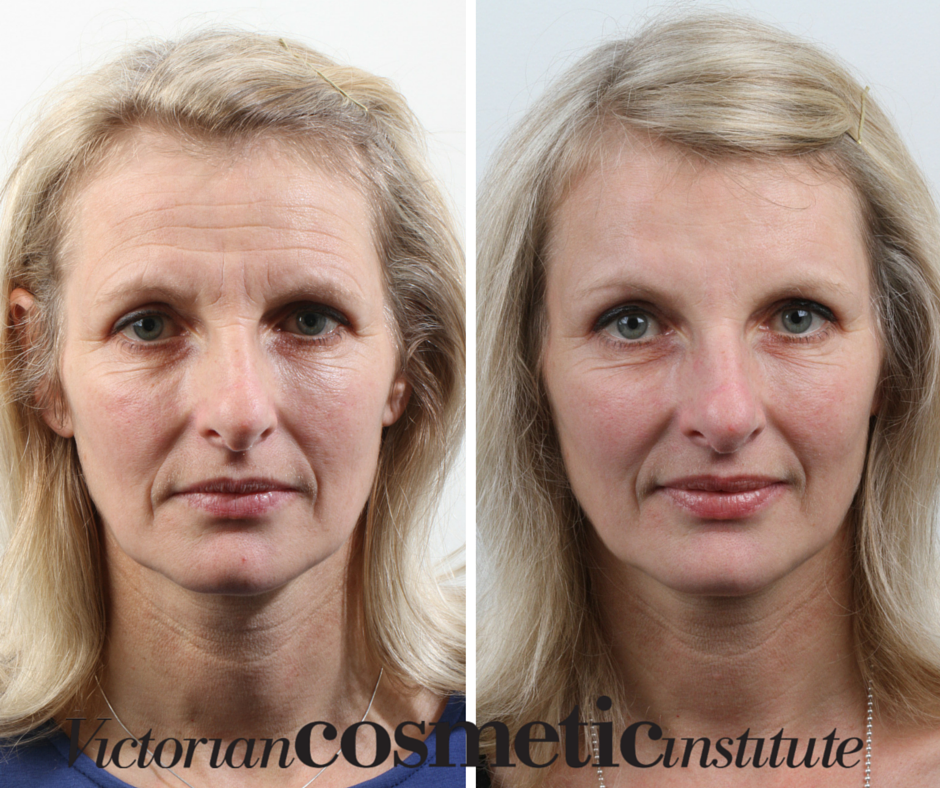Last updated: September 2023
Where can dermal fillers be injected?
Dermal fillers are injected beneath the skin, usually in the subcutaneous fat layer or deeper. Treatable areas include;
- lips
- cheeks
- tear troughs (treatment no longer performed at Victorian Cosmetic Institute)
- noses (treatment no longer performed at Victorian Cosmetic Institute)
- chins
- jawlines
- foreheads
- temples
- back of hands
Ironically, despite their name, ‘dermal’ fillers are not commonly injected into the skin or dermis to treat wrinkles. Instead, dermal fillers are primarily used to volumise areas on the face. A popular example is lip enhancement, where dermal fillers enhance lip size and shape.
Less commonly known, dermal fillers can smooth transitions between adjacent areas of the face. For example, fillers can smooth the jowl-to-chin transition to help straighten the jawline.
Replacing facial volume loss due to ageing or weight loss is also an important use of fillers, for example, volumising the cheeks or the temple region.
More recently, bio-remodelling dermal fillers with high concentrations of hyaluronic acid have been used to stimulate collagen production. These provide virtually no volume changes in the face but are targeted at improving skin quality.
What are dermal fillers made of?
The most commonly used dermal fillers are made from hyaluronic acid, of which many brands are available. Hyaluronic acid is found naturally in our bodies; however, in dermal fillers, the hyaluronic acid chains are chemically cross-linked, giving it a gel-like consistency. The amount of cross-linking determines the gel’s firmness and longevity. Thicker fillers have greater cross-linking and are typically firmer, placed deeper in the face, and are used to volumise. Finer fillers with less cross-linking are generally softer and smoother, can be placed more superficially than thicker fillers, and are used for areas where the skin is finer.
One of the critical properties of hyaluronic acid is that it is water-loving. This property often leads to hyaluronic acid being a crucial ingredient in moisturisers. In filler form, hyaluronic acid can attract its weight in water many times, leading to greater volumisation than the amount injected.
Hyaluronic acid fillers are reversible by injecting the enzyme hyaluronidase. This is useful for the treatment of misplaced or excess hyaluronic acid fillers.
Permanent fillers*, however, are much less commonly used because they are not reversible unless surgically removed. Examples include silicone, polyacrylamide, and polymethyl methacrylate (PMMA).
*Permanent fillers are not performed at the Victorian Cosmetic Institute due to the higher risks of permanent filler treatment.
How long do dermal fillers last?
The generally accepted longevity of temporary hyaluronic acid fillers is from 6 to 18 months. We recently challenged this by performing MRI scans of patients’ faces who had hyaluronic acid fillers several years ago. Our findings indicate that temporary hyaluronic acid fillers may last for over ten years in many cases. This finding also correlates to our clinical observations. For example, we have often found fillers to last in tear troughs for over ten years.
Despite their unexpected longevity, the reversibility of hyaluronic acid fillers with an enzyme called hyaluronidase is still possible at any time.
Given the possible longevity of fillers, we consider it important to use smaller amounts at infrequent intervals. This will prevent over-filling of the face through the accumulation of filler.
How much dermal filler should I have?
It is common practice to inject one mL of filler into each part of the face. For example, 1mL is a standard volume injected into the lips. This tendency could be because fillers are mostly packaged and sold in 1mL syringes. Furthermore, as the expected longevity of hyaluronic acid fillers is 6 to 18 months, they typically get re-injected every 6 to 18 months. However, our recent MRI study findings suggest that filler lasts much longer – often many years. Therefore, overfilling may occur if the filler is repeatedly injected into the same areas of the face every 6 to 18 months.
Often we advise using 1mL of filler for multiple areas on the face rather than just in one place. This allows for a more balanced approach to filling the face. Small amounts are put in each area rather than a whole mL or more. With careful placement, it is possible to use smaller amounts to achieve better results without overfilling the face. The face should be carefully assessed before each session to determine the need for filler. Putting in fillers at regular 6 to 18-month intervals without paying attention to aesthetics will likely lead to overfilling and poor outcomes.
The process of having dermal fillers
A consultation is required before having fillers done. This is to provide your treating practitioner with your history and allow for an assessment of your face. The volumes, areas to be injected, and cost can then be planned.
The treatment begins by cleaning the face using an antiseptic. Local anaesthesia is often used to numb the treatment areas. The filler can be injected with either a needle or a cannula. We prefer cannulas rather than sharp needles for most areas of the face. Unlike needles, cannula tips are blunt.
To help visualise the location of blood vessels before the filler injection, we utilise a device called Accuvein to detect veins and an ultrasound device to detect arteries. Using these devices in combination with blunt-tipped cannulas helps avoid puncturing or entering blood vessels and causing complications such as bruising or vascular occlusion.
During the procedure, your practitioner will regularly assess the placement and effect of the filler to create the desired results.
Most filler injections take 30 to 60 minutes and are done in the clinic setting.
What are the common side effects or complications of having dermal fillers?
These include;
- Temporary redness, especially around the point of entry of the cannula or needle.
- Pain
- Bruising
- Swelling
- Unwanted spread or migration of the filler
- Asymmetries in the face
There is usually some transient redness after the injections. Swelling is also present after the procedure, especially with lip enhancement. You will see some results immediately after the procedure but not the full results for a few weeks. During this time, the swelling subsides, and the filler ‘hydrates’ and integrates into the tissues of the face.
Bruising can also occur; if it does, it typically takes a week or two to disappear completely.
Asymmetry is also possible but correctable on a subsequent visit. Small lumps can occur, either dissipating in a few weeks or requiring dissolving with a different injectable product called hyaluronidase. For treatments around the eyes, puffiness can occur, and if present after one week, it will most commonly require hyaluronidase to correct. Corrections can be made in a subsequent follow-up visit, and filler can be added or removed during this time.
What are the serious risks of having dermal fillers?
Infection is a rare complication of dermal filler injections. Bacterial and viral infections (such as cold sore reactivation) can occur post-filler treatment. We help to prevent these complications through proper cleansing of the skin with antiseptic before treatment. If you have a history of cold sores and the treatment area is around the mouth, you should notify your treating doctor, as filler treatment can cause cold sore flare-ups. If this is the case, you may be instructed to take anti-viral medications before treatment.
Immune-mediated reactions to filler can lead to hardening or lumpiness of the filler injected and can also be delayed in their presentation, occurring weeks or months after filler injections.
Vascular occlusion from dermal filler injections is a rare but severe side effect of dermal filler injections. To reduce this risk, we use the following;
- Blunt-tip cannulas rather than needles to inject the filler product. Blunt-tip cannulas can help to avoid blood vessels by pushing them away instead of entering them.
- Ultrasound scanning before or during injection of filler – to scan for and avoid arteries in the treatment area
- Injecting smaller amounts at slower rates – to minimise the risk of any intravascular injection.
Unusual changes in the skin post-treatment, such as sudden blanching, pain, prolonged redness, or even acne-like pustules, are often signs of vascular occlusion. Blindness and even a stroke is a rare risk of injecting filler into the arteries supplying the retina and brain respectively.
All serious risks of filler treatment should be considered before treatment.
FAQs
How much do dermal fillers cost?
Our doctors will discuss this with you in your initial consultation, as the cost of your treatment will vary depending on your area and how much filler is required.
Click here for the full price list.
What is the difference between anti-wrinkle injections and dermal fillers?
Despite having different actions and results, they are commonly used together.
Anti-wrinkle injections relax the muscles of facial expression that cause wrinkles in the skin and provide no additional volume to the face. The typical longevity of anti-wrinkle injections is from 3 to 4 months.
Conversely, dermal fillers are injected to shape, contour and volumise the face. The longevity of fillers is significantly longer than anti-wrinkle injections.
Why choose Victorian Cosmetic Institute as your provider of dermal fillers?
Our dermal filler injectors have many years of experience. We allow you ample time to communicate your aesthetic goals to us, and use our expertise to help you achieve your desired outcome. Our goals for our patients is to achieve natural-looking results using the least amount of filler possible to achieve your result. The first step is simply contacting us for your initial dermal filler consultation, where we will discuss with you what is a realistic and achievable outcome, and what to expect from your treatment.
Our goals with your filler treatment are to;
- Provide you with a careful and honest aesthetic assessment
- Create natural-looking enhancements using the smallest amount of filler possible
- Cause as little bruising and swelling as possible
- Mitigate severe complications such as vascular occlusion through the use of ultrasound scans prior to treatment
To make an appointment, click the book online button at the top of the page or call us on 1300 863 824.

